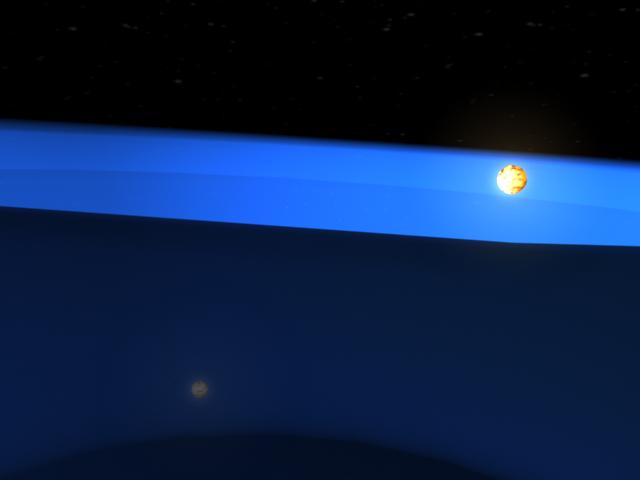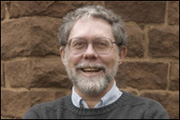Professor, Alumna Observe Initial State of Earth-Like Planet Formation
 |
| Professor of Astronomy Bill Herbst observed sand-like grains in space through the reflection of light from stars. These grains are the building blocks of an Earth-like planet. |
| Posted 03/17/08 |
| For the first time, astronomers have observed the initial phase in the formation of an earth-like planet.
What Herbst, Hamilton and other astronomers on the team observed was that a protoplanetary disk, or ring, around the binary star known as KH 15D, is composed of solid particles larger than what is usually observed in space. For hundreds of years, scientists have been theorizing that Earth-like planets form when gas and dust around a star get compressed into these disks and the material begins to coalesce into planets. But until now we never had the ability to study this process in detail, Herbst says. The unique geometry presented by KH 15D and the way the light was being reflected off the disk allowed us to get a good look at the structure of the disk. We were amazed at what we saw. The disk orbiting KH 15D is at least the size of Jupiters orbit and composed of sand-sized grains that have grown from microscopic-sized particles to form the larger grains. These grains are now approximately 1mm in diameter, much larger than the tiny particles typically seen in space. This is also the characteristic size of “chondrules, small glassy spherules that are found in the most primitive solar system, the so-called carbonaceous chondrite meteorites. A Flash animation of what the team observed can be seen here: The observations of the disk were made over several years using some of the largest telescopes in the world, including the 10-meter telescope of the W.M. Keck Observatory in Hawaii. More modest telescopes, including the one at Wesleyan Universitys Van Vleck observatory and the Maidanak Observatory in Uzbekistan, were also used in the study. Located approximately 2,400 light years from earth and also known within the astronomical community as the winking star, KH 15D was first documented in 1995 by Herbst and his then-graduate student Kristin Kearns ’98. An ensuing Ph.D. thesis by Hamilton further solidified the importance of this star and brought it to the attention of the astronomical community. In 2004, two groups of astronomers on opposite coasts showed that KH 15Ds winking was a result binary star with an orbiting period of 48.36 days within a large disk. The winking effect was generated as one of the stars alternately rose above and set below the disk. What Herbst, Hamilton and the rest of the team observed recently is that the disk is slowly hiding the stars from view and putting them in a permanent state of faintness, though still visible by the reflection off the disk. Because of how the light is being reflected there are opportunities to make observations about the chemical composition of these sand-like particles, Herbst said. Thats very exciting because it opens up so many doors for new type of research on this disk. The members of the Herbst’s team documenting the observations include Hamilton, Katherine LeDuc MA 07; Joshua Winn of the Massachusetts Institute of Technology.; Christopher Johns-Krull of Rice University; Reinhard Mundt of the Max-Planck-Institute for Astronomy in Heidelberg, Germany; and Mansur Ibrahimov of the Ulugh Bek Astronomical Institute in Tashkent, Uzbekistan. Support for the work has come over the years from NASA’s Origins of Solar Systems program and from the W. M. Keck Observatory Principal Investigator’s Fund. For more information, go to https://wesfiles.wesleyan.edu/home/wherbst/web/KH15D. |
| By David Pesci, director of media relations. Video still and video by Wesleyan’s Academic Media Studio. |


 The discovery, highlighted in the March 13 issue of Nature, was documented by a team of astronomers led by William Herbst, the John Monroe Van Vleck Professor of Astronomy, chair of the Astronomy Department and director of the Van Vleck Observatory (pictured at right) and Catrina Hamilton, Ph.D 03, assistant professor of physics and astronomy at Dickinson College in Carlisle, Pa.
The discovery, highlighted in the March 13 issue of Nature, was documented by a team of astronomers led by William Herbst, the John Monroe Van Vleck Professor of Astronomy, chair of the Astronomy Department and director of the Van Vleck Observatory (pictured at right) and Catrina Hamilton, Ph.D 03, assistant professor of physics and astronomy at Dickinson College in Carlisle, Pa.